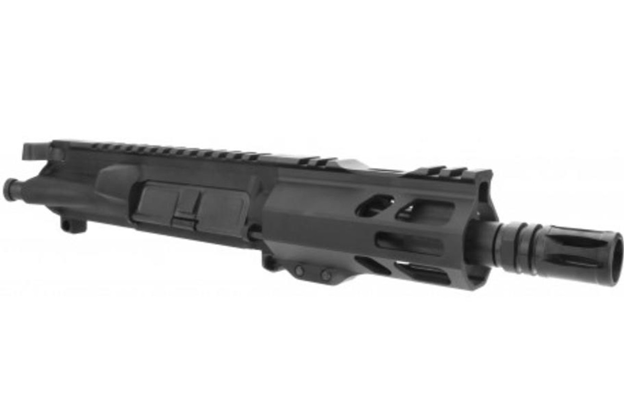While it may be the case that the majority of AR style platforms out there are built around either the .223 or 5.56, or around hybrid uppers with .223 Wylde chambers that can handle either ammunition, there are plenty of serviceable alternatives to these cartridges.
One is the .300 BLK, also known as .300 AAC Blackout and .300 Blackout. This cartridge, which is basically a necked-out 5.56/.223 casing that fires a much heavier bullet, offers some unique comparative advantages with respect to performance.
There are also some things you should know before getting a .300 BLK upper or building a dedicated rifle around one. Here are some of the most important.
Why .300 BLK Instead of .223 or 5.56?
There are several comparative advantages that .300 BLK offers when compared to either .223 or 5.56.
One of the most important of these is that, since the .300 BLK fires a larger, heavier bullet, it produces considerably more stopping power than its smaller cousins. This makes it ideal for close-quarters engagements, especially when the purpose is threat neutralization, not just target shooting.
It is also slower and when loaded with an appropriate bullet is less likely to overpenetrate, which gives it another advantage in terms of ballistic performance and defensive use.
Moreover, the .300 BLK, because it hits harder, is preferred by some for close-range dispatch of certain game, like hogs or coyotes. With proper shot placement any of the cartridges mentioned here can be effective, but since .300 BLK hits harder, it is preferred for tougher game, like hogs, that are dangerous when wounded.
Another serious advantage of the .300 BLK when compared to the .223 and 5.56 has to do with the cartridge’s ability to fully deflagrate its propellant charge in a much smaller barrel. This means .300 BLK performs well from very short barrels, including AR pistol barrels, making it ideal for carbines and shorter builds, with which no ballistic potential will be left on the proverbial table.
Another thing is that .300 BLK responds well to suppression, and many loads commercially available for it are subsonic to begin with; shooting these rounds suppressed offers serious control over noise as well as reduced recoil, and the cartridge performs very well given these considerations.
Is There Anything Else to Know About It?
With all that we’ve said so far, there are some shortcomings associated with the cartridge that in fairness need to be explored.
Two of the most pronounced of these are the .300 BLK ammo is fairly expensive and can also be hard to find. Not all shops will carry it, which is a pointed detractor. However, one potential workaround here is that you can neck out .223 and 5.56 brass to load your own .300 BLK, if you have a reloading press, the raw materials, and the means to do so.
Another is that, despite the admirable close-range performance of .300 BLK, and the fact that it performs well from a short barrel, even a suppressed one, its long-range performance is abysmal.
The .300 BLK drops like a rock, and beyond 100 yards or so, not only will its accuracy suffer, but you’ll need to hold way over a target to hit it. It’s just not a good long-range performer, whereas 5.56 and .223 (and other cartridges) are.
What About .300 BLK Uppers?

Now that you know some of the advantages associated with .300 BLK, as well as some of the shortcomings, you might be wondering if it’s worth it for you to build with a dedicated .300 BLK upper.
If you are looking for a short rifle that will perform well at close ranges and offer superior stopping power to both .223 and 5.56, and the extra price and poor long-range performance don’t bother you, then the project might well be worth it.
It’s also worth mentioning that a lot of parts can be used in common between .300 BLK and 5.56 and .223 builds. In fact, the only part that you may have to swap is the barrel. The BCG and many other 5.56 parts will work interchangeably with many .300 BLK builds.
That’s another thing to consider; you might even be able to use the same 5 56 mags with .300 BLK. Just be very careful that you know what you are loading and shooting and where, as it is dangerous to mix ammo.
Here for .300 BLK Uppers or Parts?
Thinking about getting started on a .300 BLK build with a dedicated .300 BLK upper and other parts? Get what you need from our collection; in addition to complete, assembled upper receivers, we carry a variety of AR pistol uppers and parts, along with other AR parts for 300 BLK builds. Check them out in our collection and get in touch with us at Sales@MCSGearup.com if you have any questions.

